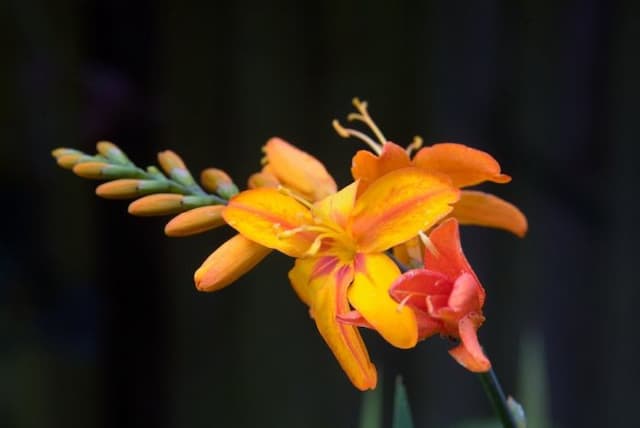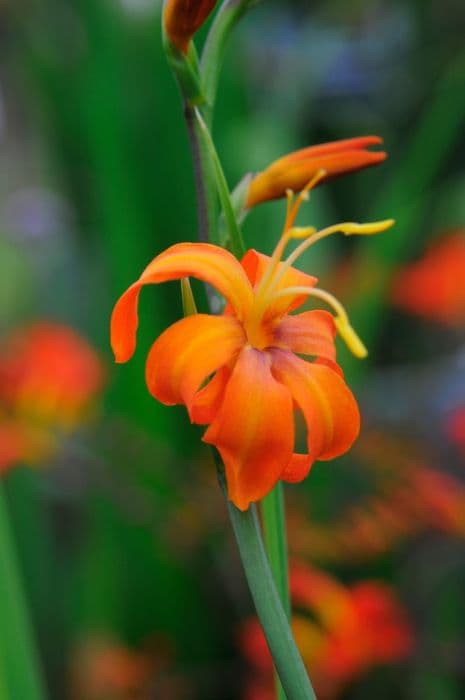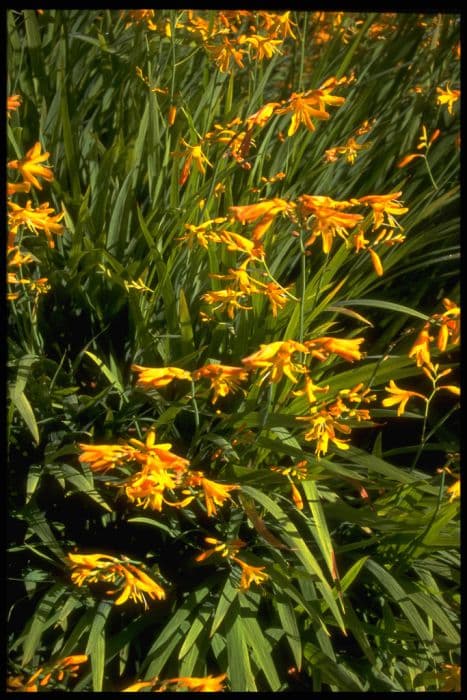New Zealand Iris Libertia ixioides 'Goldfinger' (v)

ABOUT
Libertia ixioides 'Goldfinger', commonly known as New Zealand Iris or sometimes simply Libertia, is an evergreen perennial known for its striking foliage and architectural appeal. The plant has a tufted, grass-like appearance with narrow, upright leaves. The leaves of 'Goldfinger' are particularly notable for their vibrant coloration; they boast a golden-yellow hue that intensifies in the presence of sunlight, providing a luminous contrast to the green shades more typical in a garden setting. During the blooming period, New Zealand Iris produces delicate, small white flowers that emerge on slender, stiff stems well above the foliage. These blooms have a simple, yet elegant three-petaled structure, giving a star-like appearance. Following the flowering season, the plant may produce seed pods that add additional ornamental interest. The overall form of Libertia ixioides 'Goldfinger' is dense and clumping, creating a bold visual statement with its striking color and vertical growth habit. Its foliage not only has a unique color but also a somewhat stiff and sword-like texture, contributing to a somewhat spiky look that can add both texture and a splash of color in garden designs. The plant's evergreen nature ensures that it retains its appeal throughout the year, making it a valuable addition to landscapes for continuous interest.
About this plant
 Names
NamesFamily
Iridaceae
Synonyms
Goldfinger New Zealand Iris, Goldfinger Tukauki, Goldfinger Libertia
Common names
Libertia ixioides 'Goldfinger'
 Toxicity
ToxicityTo humans
Libertia 'Goldfinger' is generally not known to be toxic to humans. There are no well-documented symptoms of poisoning from this plant, as it is not commonly ingested. As with any non-food plant, ingestion may potentially cause gastrointestinal discomfort or an allergic reaction in some individuals, but specific toxicity is not reported.
To pets
Libertia 'Goldfinger' is also not known to be toxic to pets. There is no evidence to suggest that ingestion of this plant by pets would lead to poisoning. As with humans, the plant is not intended for consumption, and while it is not specifically poisonous, eating non-food plants can sometimes cause mild stomach upset in animals.
 Characteristics
CharacteristicsLife cycle
Perennials
Foliage type
Evergreen
Color of leaves
Green
Flower color
White
Height
2 feet (0.6 meters)
Spread
2 feet (0.6 meters)
Plant type
Herb
Hardiness zones
8
Native area
New Zealand
Benefits
 General Benefits
General Benefits- Drought tolerance - Libertia ixioides 'Goldfinger', commonly known as New Zealand Iris, is well-suited to withstand periods of low water availability.
- Low maintenance - New Zealand Iris generally requires minimal care once established, making it ideal for gardeners seeking easy-to-care-for plants.
- Attracts wildlife - The flowers provide nectar and attract beneficial insects like bees and butterflies to the garden.
- Year-round interest - This variety features striking golden-yellow foliage that provides visual interest in the garden throughout the year.
- Soil adaptability - New Zealand Iris can grow in a range of soil types, although it prefers well-drained conditions.
- Structure in garden design - Its distinctive upright form adds vertical structure and texture to garden beds and borders.
- Erosion control - The fibrous root system of New Zealand Iris helps stabilize soil and can prevent erosion on slopes.
 Medical Properties
Medical PropertiesThis plant is not used for medical purposes.
 Air-purifying Qualities
Air-purifying QualitiesThis plant is not specifically known for air purifying qualities.
 Other Uses
Other Uses- Photography: Libertia Goldfinger's striking foliage and white flowers can create an interesting contrast in botanical photography, making it a favored subject for plant photographers.
- Crafts: The dried stems and seed pods can be used in floral arrangements or as components in wreaths and other dried plant crafts.
- Erosion control: This plant's root system helps to stabilize soil in sloped gardens or areas prone to erosion.
- Educational tool: Its distinct form and growth pattern makes Libertia Goldfinger a good candidate for botanical studies and educational gardens.
- Landscape design: Its gold and green variegated leaves can be used to create patterns or color themes in landscape design projects.
- Illumination: When planted en masse, they can reflect moonlight or garden lighting to create a luminescent effect during the night.
- Thematic gardens: Included in New Zealand native-themed gardens to represent the local flora or in gold-themed gardens for its color.
- Art inspiration: The plant's form and texture serve as inspiration for artists and designers seeking natural shapes and patterns.
- Seasonal decoration: Its evergreen nature means clippings can be used in seasonal decorations that require freshness over long periods.
- Urban greening: Utilized in urban planting schemes to improve biodiversity and add native plant species to cityscapes.
Interesting Facts
 Feng Shui
Feng ShuiThe Libertia is not used in Feng Shui practice.
 Zodiac Sign Compitability
Zodiac Sign CompitabilityThe Libertia is not used in astrology practice.
 Plant Symbolism
Plant Symbolism- Resilience: The Libertia ixioides 'Goldfinger', commonly known as the 'Goldfinger' New Zealand Iris, is a plant that thrives in tough conditions, symbolizing the ability to endure and adapt.
- Purity: Reflective of many members in the Iris family, the 'Goldfinger' New Zealand Iris often represents purity due to its strikingly clean lines and elegant blooms.
- Beauty: With its eye-catching golden-striped foliage and delicate white flowers, the 'Goldfinger' New Zealand Iris is often associated with beauty and the appreciation of nature's artistry.
- New Beginnings: As with other Iris species, this plant can symbolize new beginnings or hope, with its fresh growth and resilient nature signaling a fresh start or a turn of the season.
 Water
WaterTo maintain a healthy Toffee Twist, water it deeply once a week, providing about 1 to 1.5 gallons of water each time, depending on the weather and soil conditions. During hotter, dryer periods, you may need to water it more frequently, possibly twice a week, to keep the soil moist but not waterlogged. Reduce watering in cooler months to prevent root rot. Always check the top inch of the soil before watering; if it feels dry, it's time to water again.
 Light
LightToffee Twist thrives in full sun to partial shade, meaning it requires at least 4-6 hours of direct sunlight per day, with some relief during the hottest part of the afternoon. The ideal spot would be one that gets bright morning light and dappled or light shade in the afternoon to protect its foliage from scorching.
 Temperature
TemperatureToffee Twist does well in a wide range of temperatures but prefers conditions between 65°F and 75°F for optimal growth. It can tolerate minimum temperatures down to 20°F but should be protected from frost to avoid damage. Maximum temperatures should not exceed 90°F for extended periods as excessive heat can stress the plant.
 Pruning
PruningPruning Toffee Twist is primarily for aesthetic purposes and to remove any dead or damaged foliage, enhancing its appearance and promoting healthy growth. Prune in late winter or early spring before the onset of new growth. Cut back up to one-third of the older stems to allow light into the center of the plant for better air circulation.
 Cleaning
CleaningAs needed
 Soil
SoilThe New Zealand Iris, 'Goldfinger' thrives in a well-draining soil mix with a slightly acidic to neutral pH of 6.5 to 7.2. A mixture containing equal parts of loam, sand, and peat or compost is ideal. Ensure the mix allows for good aeration and drainage to prevent waterlogging, which can be detrimental to the plant's health.
 Repotting
RepottingNew Zealand Iris 'Goldfinger' does not require frequent repotting and should be repotted every 2 to 3 years or when it has outgrown its current container. This slow-growing plant prefers to be somewhat root-bound, so avoid repotting too often unless necessary to refresh the soil or divide the rhizomes.
 Humidity & Misting
Humidity & MistingNew Zealand Iris 'Goldfinger' is tolerant of a range of humidity levels but prefers moderate humidity. It can thrive in both drier conditions and in areas with higher humidity, reflecting its adaptability to various garden settings.
 Suitable locations
Suitable locationsIndoor
Place in bright, indirect light with well-draining soil.
Outdoor
Plant in sunny to part-shaded area; protect from high winds.
Hardiness zone
8-10 USDA
 Life cycle
Life cycleLibertia ixioides 'Goldfinger', commonly known as New Zealand iris 'Goldfinger', initiates its life cycle as a seed, germinating in moist, well-drained soil in a sunny or partially shaded location. Once the seedling emerges, it grows into a clump-forming perennial, developing narrow, upright, sword-like leaves that are golden-yellow in color. The plant enters a vegetative stage, where it focuses on leaf growth and establishing a robust root system. After the vegetative phase, usually in late spring to early summer, the New Zealand iris produces white, iris-like flowers on stems that rise above the foliage. Following the flowering stage, seed capsules form and mature, eventually releasing seeds to start the next generation. The plant typically maintains a healthy appearance year-round, with die-back occurring in parts of the clump as it becomes overcrowded, necessitating division and propagation to rejuvenate and continue the life cycle.
 Propogation
PropogationPropogation time
Spring to summer
Propogation: Dividing established clumps is the most popular method for propagating Libertia ixioides 'Goldfinger', commonly known as New Zealand Iris. This process is typically done in the spring or early summer, when the plant is actively growing. To divide the plant, gently lift the entire clump from the ground, being mindful of the fragile root system. Using a sharp, clean knife or spade, the clump is cut into smaller sections, ensuring that each section has several growing points. The divisions are then replanted in moist, well-draining soil, spaced about 12 to 18 inches (approximately 30 to 45 centimeters) apart to allow sufficient room for growth. After planting, it's essential to water the new divisions thoroughly to help establish them in their new location.
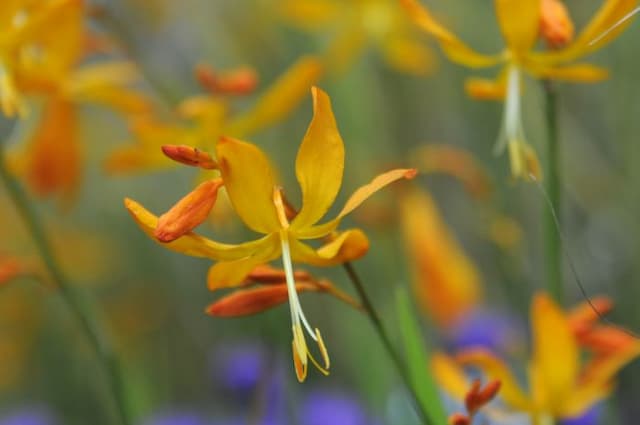
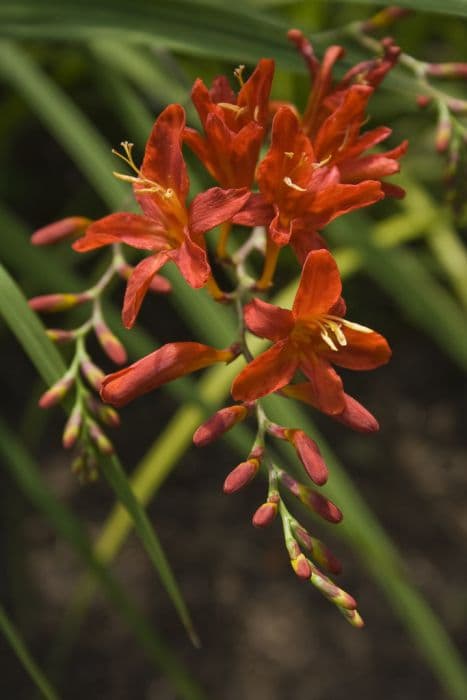
![Montbretia [Bright Eyes]](/_next/image?url=https%3A%2F%2Fplants-admin.emdemapps.com%2Fimages%2Fplants%2F%2Fimages%2F604b5f4a483b6.png&w=640&q=75)
